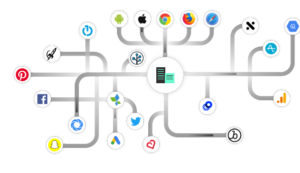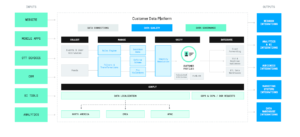
Do You Need a CDP? And Other Data Mysteries

In the mad rush to leverage big data, a multitude of data-oriented systems have been created, from data lakes and warehouses to data hubs, and even fabrics and meshes. For certain types of data opportunities, however, a customer data platform (CDP) may be your best approach to achieving data nirvana.
The CDP is a relatively new concept that has emerged in recent years to streamline the integration, management, and governance of data. But a CDP doesn’t focus on just any type of data–it’s primarily concerned with customer data (as its name would suggest).
Here’s how the Customer Data Platform Institute puts it: “A Customer Data Platform is packaged software that creates a persistent, unified customer database that is accessible to other systems.”
There are three elements that make up a CDP, according to the CDP Institute. First, a CDP is a packaged application that should be relatively easy to deploy and configure; much less so than a data warehouse deployment, it says.
Secondly, a CDP “creates a comprehensive view of each customer by capturing data from multiple systems, linking information related to the same customer, and storing the information to track behavior over time.” This is the heart of the CDP goal, and ties into the third principle which is that CDPs can be used by other system for analytics and to manage customer interactions.
According to Chee Chew, the chief product officer of CDP developer mParticle, CDPs provide that “single version of the truth” for customer data. The need for CDPs has grown in recent years, particularly among organizations that have adopted many different SaaS applications, he says.
“If you back up the clock 15 to 20 years, there were more suites of applications, a lot of them on prem. You bought the suite that handled everything for you, and the suite had one data store, so you had access to everything,” Chew tells Datanami.
“But with cloud computing in the modern world, you have these amazing startups up create this innovation on one aspect,” he continues. “Your call center might have Zendesk here and ServiceNow here and a knowledge base there and a CRM. You have five or six systems put together to run your contact center each, of which have their own data store.”
The problem is that Zenddesk doesn’t share its data store with ServiceNow, and Salesforce data isn’t available in Snowflake. The data describing any single customer exists in a fragmented way across all of these different systems, making it nearly impossible to get a coherent view of the customer.
“A CPM like us, we return that feeling of one suite of data and one repository,” Chew said. “That’s what we want to do.”
New privacy rules like CCPA and GDPR have upped the ante for CDPs. While some companies may have tried to hack their own CDP by stringing various systems together with ETL scripts and integration code, that approach comes with considerable risk, particulary as the number of systems and the volume of data increase.
“Sometimes the developer starts off and says, ‘oh I just need to write an ETL script and I’ll be able to export it from my Snowflake over the system,’” Chew said. “And that kind of works initially. And then someone else comes along and says, ‘Oh I have something else’ and they write another one and write another one.
“And then the privacy officer comes in and says ‘Oh we need you to enforce this across everybody,’” he continued. “And then it gets a lot more complicated. You kind of boil the frog.”
mParticle’s CDP tracks when a customer gives consent for a company to collect and use its data, and when a customer declines that request. When a marketer goes to build his marketing campaign in Marketo, for example, mParticle’s CDP will automatically have removed that customer’s name and data from the system, which helps keep the company from running afoul of new privacy regulations.
But CDPs are not just handy for defensive use cases. By surfacing customer insights in the employee-facing tools when the employees need it, the CDP can also help to build growth.
For example, before managing mParticle’s CDP, Chew helped manage the CDP used at Amazon.com. One of the uses of Amazon’s CDP was to surface data about sales returns onto the screens used by the customer service representative (CSR). Based on the customers’ past history, the Amazon CSR may choose to make the return a “no return” return –that is, to forgive the purchase entirely.
“When you call Amazon and you need to make a return, they’re looking at your profile to assess how trustworthy are you, what’s your long-term value, and how much benefit they would give you if they like forgave the return,” Chew said. “So it’s really a value for the entire company.”
mParticle is one of a growing group of vendors prowling the growing CDP market. The New York City-based software company, which raised $150 million in a Series E earlier this month at an $800 million valuation, has attracted customers like NBC Universal, Jack-In-The-Box, Airbnb, and Burger King.
The company recently launched a new Data Planning tool that’s designed to ensure that only high quality data makes it into data repositories. According to Chew, the tool allows data analysts or marketers to define the data schema for incoming data, including what the accepted values for given data fields are. If a piece of data fails to adhere to that schema, then the CDP will flag the data, reject it, and send a notice back upstream to cleanse the data.
“The Data Plan is a way of identifying and enforcing conformance to the schema,” Chew says. “That way you know that what comes out is really clean
CDP may not be the right architectural approach for every big data project. But if your sales or marketing team is using a plethora of SaaS tools, is confounded by dirty data, and is struggling to comply with emerging privacy laws, it might be something to check out.
Related Items:
Data Mesh Vs. Data Fabric: Understanding the Differences
A Peek At the Future of Data Management, Courtesy of Gartner
Customer Data and Analytics Platforms: Build or Buy?
































